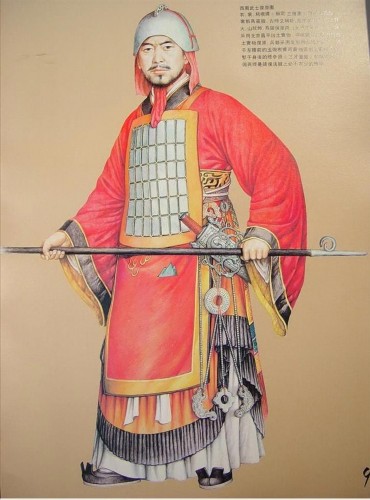
Western Zhou Dynasty (1100BC-771BC)
Eastern Zhou Dynasty ( or known as The Spring and Autumn Period The Warring States Period) (770 BC to 221 BC)
In the 8th century BC regional entities began to assert their independence from the Zhou state, fighting among themselves for dominance as well as fending off attacks from barbarian neighbours. By the late 5th century power was concentrated in seven principal states – Han, Wei, Zhao, din, Chu, Van and Qi. They all built enormous walls to protect their borders, fortified their cities and even their villages, and constructed roads and canals to expedite the movement of troops and supplies. As military technology and the science of warfare flourished, the organization, weaponry and ferocity of the Qin army combined to give them superiority over the other Warring States, and in 221 BC the Qin united the whole area to form the first Chinese empire.
By the sixth century, the Zhou dynasty was beginning to falter. According to traditional sources, its beginning was glorious, starting about 1045 when King Wu (Woo) claimed the Mandate of Heaven, ousted the wicked last king of the Shang dynasty, and established a new regime. Finding that his kingdom was too large to govern by himself, he divided it into smaller territories and appointed local rulers whom he allowed to run their own lands as they saw fit, so long as they provided him with military and financial assistance on request. Of course, the people he trusted enough to make dukes (basically junior kings) were his relatives, and he had a lot of them. In addition, as new territories were brought into the Chinese cultural sphere, new states were created, and the kings of Zhou made sure the rulers of those regions were bound to the royal house by marriage ties and ritual oaths of allegiance. By the beginning of the eighth century, there were some two hundred states, most fairly small.
This system, similar to the feudalism of medieval Europe, worked well enough for several centuries, but as kingdoms were passed from generation to generation, the ties of kinship weakened, the kings of Zhou were no longer able to enforce order, and states began to compete with one another for resources and for territory. “Compete” is actually a euphemism for warfare, and the later Zhou dynasty was characterized by incessant, bloody fighting as states attempted to destroy or annex each other. At the beginning of the Spring and Autumn Era (722–481; named for a history of the state of Lu that organized events by seasons and years), there were still some one hundred and seventy states, but by the fifth century, unrelenting warfare had reduced their number to about forty. The aptly named Warring States Era (403–221) started with seven major states and ended with one, when the state of Qin finally brought all of China under its control. Over the last five centuries of the Zhou dynasty, four out of every five years saw warfare between major states.
As competition became more intense, the old patterns of aristocratic interactions were shattered. There were assassinations, murders, coups, and even patricides, as over-eager princes killed their fathers. Noble warriors who used to regard battle as an elegant game, an opportunity to show off their valor and virtue (sometimes by granting concessions to their distinguished opponents), now slaughtered each other mercilessly, and they could even be killed by peasants armed with newly invented crossbows. Treaties could not be relied on without an exchange of hostages, and sometimes not even then. The old ceremonies were still used—for instance, treaties were still sealed by rulers killing a bull and smearing its blood on their lips while swearing to the gods that they would uphold its provisions—but no one cared for the old gods anymore (they were, after all, the patron gods and ancestors of the very much weakened royal house of Zhou), and people began to speak of “breaking an oath while the blood is still wet on the lips.” States lied to each other, double-crossed each other, negotiated secret treaties, and made and dissolved alliances with dizzying speed.
Rulers who worried about preserving their states, the sacrifices to their ancestors, and even their own lives started looking around for help. In this way, the breakdown of the old feudal order brought a surprising degree of social mobility as clever, eloquent men wandered from state to state, looking for a ruler who would put their ideas into practice, and rulers welcomed anyone who could promise them some advantage over their foes. The search for political, social, and economic stability fueled the creation of the “hundred schools of philosophy,” and there was no end to the proposals that these wandering debaters put forward. Some were agriculturalists, who claimed new techniques for increasing the farm yields crucial to supporting large armies in the field; others knew how to construct canals; and still others were military strategists (the most famous of these was Sunzi [or Sun Tzu, Swun-zuh], whose Art of War can still be found today in most American bookstores). There were cosmologists who promised to reveal how to harness the forces of nature, logicians who analyzed argumentation itself, and even some who suggested that what the world really needed was more love (they did not last very long).